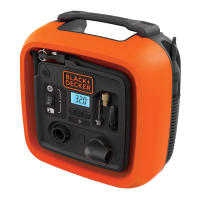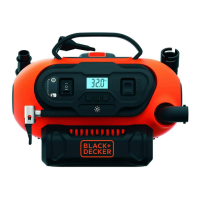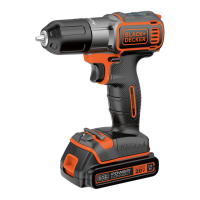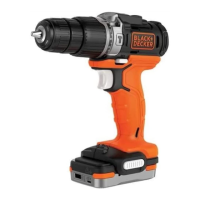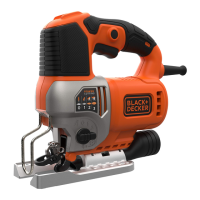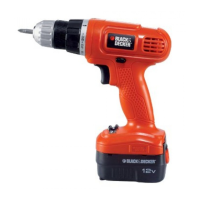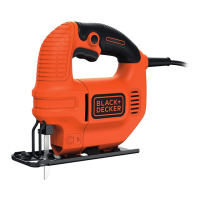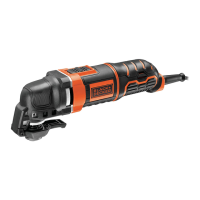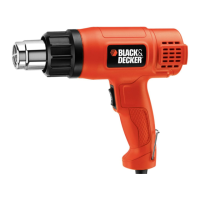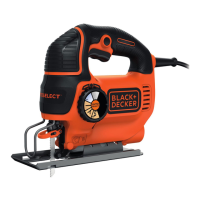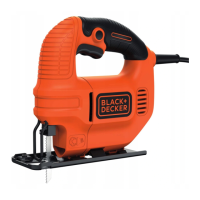ENGLISH
4
• USE SAFETY GLASSES. Also use face or dust mask if
operation isdusty.
• DON'T ABUSE CORD. Never carry tool by cord or yank it
to disconnect from receptacle. Keep cord from heat, oil,
and sharpedges.
• SECURE WORK. Use clamps or a vise to hold work.It's
safer than using your hand and it frees both hands to
operatetool.
• DON'T OVERREACH. Keep proper footing and balance
at alltimes.
• MAINTAIN TOOLS WITH CARE. Keep tools sharp and
clean for better and safer performance. Follow instructions
for lubricating and changing accessories. Inspect tool
cords periodically and if damaged, have repaired by
authorized service facility. Inspect extension cords
periodically and replace if damaged. Keep handles dry,
clean, and free from oil andgrease.
• DISCONNECT OR LOCK OFF TOOLS when not in use,
before servicing, and when changing accessories, such as
blades, bits,cutters.
• REMOVE ADJUSTING KEYS AND WRENCHES. Form
habit of checking to see that keys and adjusting wrenches
are removed from tool before turning iton.
• AVOID UNINTENTIONAL STARTING. Don't carry tool with
finger on switch. Be sure switch is off when pluggingin.
• OUTDOOR USE EXTENSION CORDS. When tool is
used outdoors, use only extension cords intended for use
outdoors and somarked.
• STAY ALERT. Watch what you are doing.Use common
sense.Do not operate tool when you aretired.
• CHECK DAMAGED PARTS. Before further use of the
tool, a guard or other part that is damaged should be
carefully checked to determine that it will operate properly
and perform its intended function. Check for alignment
of moving parts, binding of moving parts, breakage of
parts, mounting, and any other conditions that may
affect its operation. A guard or other part that is damaged
should be properly repaired or replaced by an authorized
service center unless otherwise indicated elsewhere in this
instruction manual. Have defective switches replaced by
authorized service center. Do not use tool if switch does
not turn it on andoff.
• DO NOT OPERATE portable electric tools near flammable
liquids or in gaseous or explosive atmospheres. Motors in
these tools normally spark, and the sparks might ignitefumes.
ADDITIONAL SAFETY WARNINGS FOR YOUR
INFLATOR
WARNING: FOR HOME AND CAR USE ONLY:
• Inflate bike tires, balls, rafts, swimming pool floats,
air mattresses, and more in and around the home.
Recommended maximum continuous duty at 65 psi is 2
minutes on with 5 minutesoff.
WARNING: RISK TOBREATHING.
• The compressed air from your inflator is not safe for
breathing. Never inhale air from your inflator or from a
breathing device connected to theinflator.
WARNING: RISK OFBURSTING.
• Too much air pressure causes a hazardous risk of bursting.
Check the manufacturer’s maximum pressure rating for
objects beinginflated.
• Do not leave inflator running unattended. It could burst
tires or other items.
• Use a tire gauge to check the tires pressure before each use
and while inflating tires; see the tire sidewall for the correct
tirepressure.
WARNING: RISK OF UNSAFEOPERATION.
• Do not modify or attempt to repair. Never drill into,
weld, or make any modifications to the inflator or its
attachments.
• Operate only with the accessories included or air handling
parts acceptable for not less than 160 psi. The use of any
accessory not recommended for use with this tool could
behazardous.
• Never “horseplay.” High pressure air is dangerous. Don’t
direct air-flow at yourself orothers.
WARNING: Always leave the valve adaptor lever open
when not inuse.
WARNING: RISK OF FIRE:
• Inflator can become hot during use. Allow inflator to cool
30 minutes before storingaway.
CALIFORNIA PROPOSITION 65
WARNING: This product or its power cord contains
lead, a chemical known to the State of California to
cause cancer and birth defects or other reproductive
harm. Wash hands after handling
LIQUID CRYSTAL DISPLAY FLUID
(FIRST AID MEASURES)
If liquid crystal comes in contact with your skin:
• Wash area off completely with plenty of water. Remove
contaminatedclothing.
If liquid crystal gets into your eye:
• Flush the affected eye with clean water and then seek
medicalattention.
If liquid crystal is swallowed:
• Flush your mouth thoroughly with water. Drink large
quantities of water and induce vomiting. Then seek
medicalattention.
The label on your tool may include the following symbols. The
symbols and their definitions are asfollows:
V ......................... volts
Hz .......................hertz
min ..................... minutes
or DC ......direct current
...................... Class I Construction
(grounded)
…/min ..............per minute
BPM ....................beats per minute
IPM ..................... impacts per minute
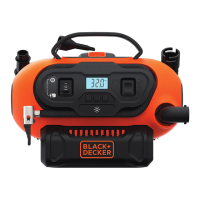
